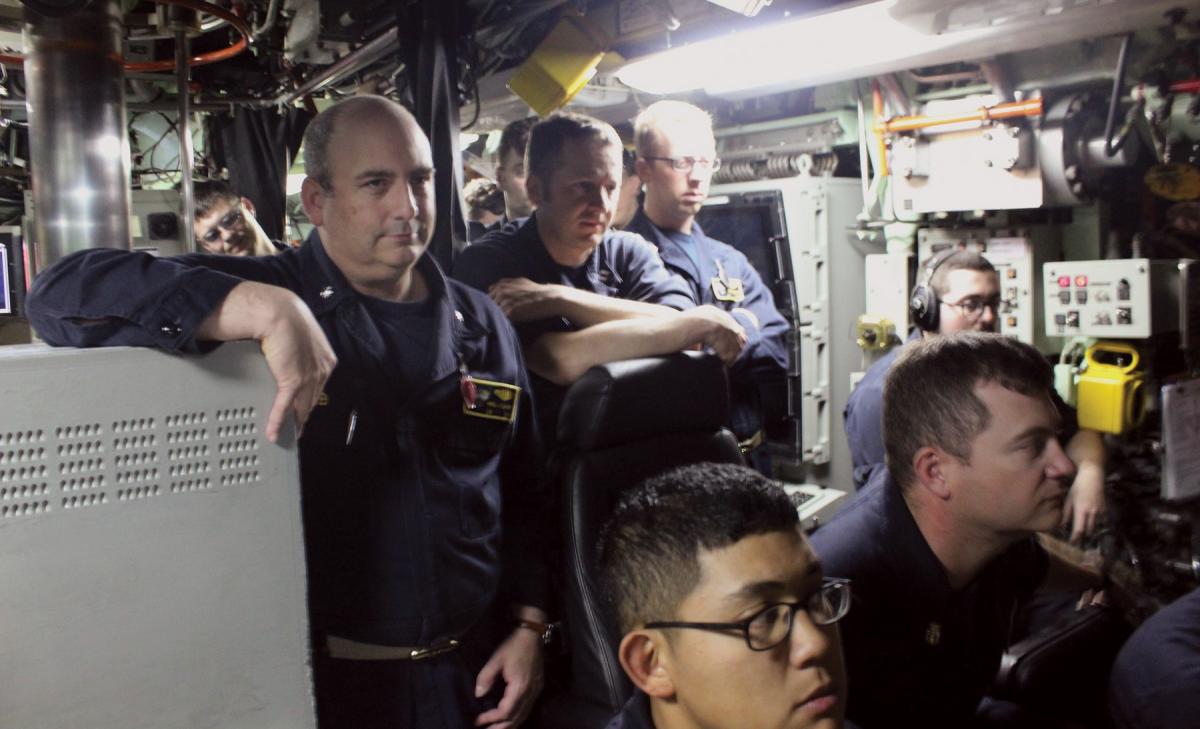As the direct representative of the commanding officer, a submarine officer of the deck (OOD) controls the ship’s operations through various enlisted supervisors and operators, who together comprise the OOD’s watch team. A prospective OOD develops the required technical skills through years of training in high-tech classrooms, simulators, and prototype propulsion systems. The interpersonal skills required to lead a watch team, however, are not taught in any formal setting. These skills must be developed on the job, honed through practice, and hardened by failure and reflection. The experiences of those who have gone before can always help the prospective OOD. To share some such experiences, the following observations are offered.
Watch Team Briefs
OODs in training often believe their orders will be the primary means of directing the ship’s operations. On the contrary, under normal conditions, the OOD’s orders are unremarkable, completing a logical cycle of dialogue and action that begins when the OOD briefs their intentions to the watch team. These briefings are the foundation of watch-team cohesion, as they prime and align the team for the orders that follow. Properly prepared teams anticipate the orders, provide missing information and alternatives, and warn the OODs who might be about to make a mistake. When expected orders come, they should be executed smartly, with minimal fanfare.
A typical watch-team brief is a concise summary of intentions that sets expectations and allows operators to plan. For example, before proceeding to periscope depth, most OODs will describe their objectives and the anticipated sequence of events, then poll the team for relevant status updates. In situations where every decision is of tactical consequence, the OOD may brief every maneuver. These should include the purpose of the maneuver (e.g., tactical positioning and target motion analysis), a general description of where the bow will be pointed, and a desired milestone to achieve before the next move, such as changing true bearing to a target of 15 degrees or closing the solution range by 2,000 yards. These briefs need not precede every order, especially those that direct emergent actions to avoid danger, but they should be routine for important tactical decisions.
The briefs achieve three goals. First and most obvious, they align the watch team to the OOD’s thinking, synchronizing efforts across the control room to a common purpose. Second, by telegraphing intentions early, they open the door for feedback in case the OOD is about to make a mistake or if a better option exists to achieve the objective. Finally, they force the OOD to think ahead about what they are doing, why they are doing it, and what they plan to do next.
Delivering efficient and effective briefs is a skill mastered with practice. New OODs tend to over-brief, saturating the control room with verbal chaff while they decide mid-sentence what they are going to do. Most OODs eventually learn to say more with less. And some, unfortunately, may neglect to brief at all, surprising their team with orders that appear to have been pulled from thin air. This dangerous habit tends to self-correct after a few preventable errors shock OODs into using their teams.
Receiving Recommendations
Having appropriately primed the watch team, the next step is to receive and process the team’s recommendations. Experienced operators will automatically use the analytical tools of their watch stations to produce an optimal maneuver. They will only be comfortable doing this routinely if the briefing process is exercised frequently, however, which is why OODs should not normally make decisions independently of the team. While the right answer may seem obvious to the OOD in times of low stress, it will be less obvious in times of high stress, when the margins for error become razor thin.
Processing the recommendation involves critically assessing and acting on it with an order. This critical assessment rarely requires more than a quick mental check but is what prevents the OOD from being merely a puppet of the watch team. In a misguided effort to demonstrate independence, some OODs will often select maneuvers that are close to but slightly different from what the team recommends. This can be a sign of insecurity and generally does more harm than good, communicating to the team that their input is not valued.
Every accepted recommendation reinforces a relationship of trust and mutual dependence between the team and their leader. Conversely, every recommendation dismissed could undermine that same relationship if the interaction is managed poorly. It is not necessary to handle the team with kid gloves or to justify every decision, but it is prudent for OODs to articulate their thoughts when they are not readily apparent to the team. While a team’s recommendation today may not be helpful, one offered tomorrow may save the mission—or the ship. If the relationship sours between the OOD and the watch team, that recommendation may never come.
Tactical harmony occurs when watch-team members resist biases and groupthink, critically challenge each other’s assumptions, and plan several steps ahead. For a team to reach this level, it must pass through the inelegant phase in which recommendations are demanded and analysis is burdened. It is worth the effort, as seeing their words and ideas transformed into ship movements is enormously satisfying for junior operators and promotes exactly the level of engagement for which OODs should hope.
Self-Assessment
A team self-assessment should routinely follow major events or mistakes. This practice may feel like a waste of time, because nobody notices when mistakes stop recurring. Given its delayed and often-imperceptible benefits, cultivating and reinforcing a ship’s self-assessment culture is largely the responsibility of supervisors, and the degree to which they own this role is a mark of their maturity as leaders.
Team self-assessments normally take the form of debriefs or “hot washes.” With inexperienced teams, OODs should set expectations for participants. They will eventually outgrow impulses to ramble, soft-pedal, or self-congratulate, but these tendencies will pervade teams still in development. Individual errors should be unambiguously understood and “owned” by the group; participants must feel encouraged to point out mistakes without fear that their teammates will suffer embarrassment or personal offense. Positive comments, on the other hand, are rarely helpful unless they merit a change in process. While it feels natural to balance criticism with praise, team self-assessments do not work like professional performance reviews. Their purpose is to identify what needs changing as efficiently as possible.
Experienced watch teams may believe they have outgrown the self-assessment routine once they achieve a high state of proficiency. To succumb to this temptation is to court disaster, however, because deployments and patrols tend to be less forgiving of mistakes than workups. Deployments also tend to stratify into long periods of single missions or operating modes, demanding intense focus on a few specific skills at the expense of all others. Contributing to the danger, a team whose performance has peaked is unlikely to perceive its own decline. Rigid adherence to the self-assessment routine, especially when it no longer feels necessary, is a proven defense against this outcome.
Discipline
If the OOD’s briefs are the foundation of watch-team cohesion, then discipline is the cement that holds it together. In the context of a submarine watch team, discipline is the team’s adherence to standards of communication, attentiveness, and doctrine. In other words, it is the consistency with which team members do what they are supposed to do in the manner they are supposed to do it. For the team’s leaders, this includes correcting the lapses that inevitably occur in their presence. In this way, the team’s collective discipline reflects the personal discipline of its leader.
Enforcing standards requires great endurance. Discipline cannot be treated as a sprint or activated only when it counts, such as when the inspection team arrives or the high-stakes mission finally occurs. Rather, it is more like a marathon of pressure applied over the weeks and months that the team does its most unremarkable work. It must be sustained when the watch team is tired and ragged, as well as when it is undertaxed. It is during routine, low-stress conditions that operators establish the patterns to which they will instinctively revert when overwhelmed by stress and complexity.
Before any sensitive operation, most teams will prepare using walkthroughs, lectures, gun drills, and other forms of deliberate watch-team training. These are useful, but in the long term they pale in importance to the day-to-day interactions that define a team’s internal dynamics. Every action or spoken word ultimately becomes a form of training, reinforcing the team’s standards and routines with constructive or destructive results.
Fortunately, the OOD does not need to sustain the marathon pace alone. Subordinate supervisors, such as the contact manager, diving officer of the watch, or sonar supervisor, are accountable to enforce standards within their respective areas. When lapses occur, rather than correcting an individual operator, the OOD should normally address the appropriate supervisor, who in turn should correct the problems. This form of communication may feel overly hierarchical at first, but is actually an important element of watch-team development. In addition to unburdening the OOD, it reinforces the operator-supervisor relationship and elevates the supervisor role within the watch team.
Morale
The relationship between discipline and morale is commonly misunderstood. A high level of discipline, so the myth goes, must necessarily result from a cold and oppressive leadership style and comes at the expense of morale. An OOD so convinced might rationalize that the watch team deserves a temporary relaxation of standards in the interest of promoting morale. In fact, discipline is not a function of the leader’s temperament, but rather of his or her endurance, and low standards are never as temporary as imagined. What the watch team deserves is to be well-led, as there is no more effective boost to morale than the well-earned win.
Morale is not the same thing as happiness, contentedness, or comfort. Only a team possesses it, not individuals, and it comes from the team’s ability to achieve its assigned purpose. While some teams with low morale may temporarily perform well, no losing team ever had high morale. An ostensibly happy but failing team may have something, but morale is not it.
Finally, if there is only one thing that prospective OODs should always remember, it is this: It is not about you. Of course, OODs must master the technical and tactical skills of the trade, but these are only prerequisites. The OOD’s purpose is to direct the intellectual firepower of an elite team, whose combined potential vastly exceeds his or her own. The OOD’s effectiveness will be measured entirely by the team’s collective performance.
When OODs first experience the surrounding machine—their entire sensory world—responding to their orders, a sense of omnipotence can result. But the machine is only a lifeless tool that requires the efforts and talent of a well-led team to accomplish even the simplest task. This team is the source of all the success and prestige OODs can hope to achieve, and the satisfaction of leading it effectively is ultimately what makes the job of a submarine warfare officer worth doing.





